How to grow Herbs in a Hydroponic Raft system
Imagine this. You want to make some dish and you need Basil. You run to the market to get some basil. You have to get a whole bunch and you only need little. You use what you need and keep the rest in the refrigerator. We all know what happens to the rest of the basil. This is mostly the case with all herbs. What if you had a Basil plant in your garden. You go to your garden, pluck what you need and use it. Nothing goes waste! and you get fresh herb.
One of the main reasons why anyone should have garden of their own is, all the exotic rare vegetables can be grown right in your garden. This makes life a lot easier since those veggies are not available easily in the market when you need them.
No points for figuring out this post is going to be on Basil! Nothing can beat the smell of Basil. Just brushing your hands on the crop brings out amazing smell. There are several varieties of Basil varying in colors and flavor. The varieties are Italian Basil, Regular Basil, Thai Basil, Lemon Basil and Fine leaved Basil. There are green and purple colored leaves as well. Basil is also very easy to grow and maintain. I used regular Basil and selected Deep-water Culture method of hydroponics to grow it in. There are several reasons why I chose that method. I wanted a system that is simple and easy to maintain. It should also be taking less space so that I can keep the whole system in my balcony.
Do you want to grow a nice herb hydroponic garden in your balcony like in this picture below ? Read on..

Basil
Basil is a common name for Ocimum Basilicum and it belongs to the family Lamiaceae (Mint family). Basil can be grown from seeds or from cuttings. Basil seeds are very small and when soaked in water they swell and form a gelatinous covering. The seeds are used in Faluda and is some drinks.
Deep Water Culture system/Raft system
In Deep Water Culture, plants are grown in a container that contains hydroponic nutrient solution meant for that crop. The plants are suspended in the nutrient solution using a net pot attached the lid. One can also use a floating raft on the container and raft can host the plants. Generally, in such a system an air bubbler is provided to aerate the nutrient solution. This process of aeration will increase the dissolved oxygen in the nutrient solution. This can also be called as raft system since the plants are floated on a raft that sits on the top of the container.

Seed starting:
Starting Basil seeds is very much similar to starting any other seed. Basil seeds are quite small. Handling them can be a little difficult. Seeds can be started in any medium. I prefer to use seed starting plugs like the ones pictured below. These are cocopeat plugs specifically meant for seed starting and cloning cuttings. Another reason why I just love these plugs is that you need not worry if you didn’t know whether or not to transplant. You can sow any seed and when it germinates, you can transplant it without any roots getting cut. The plant will not go through any transplant shock. Isn’t that nice? Another nice thing about the plug is that the sleeve is bio-degradable.So you can bury the whole thing into the soil/potting media.
The plants in the image below are couple of weeks old since they were sown in plugs. This image was taken on July, 6th.

The roots start to come out of the sleeve of the starter plugs. This can be clearly seen in the close up below.

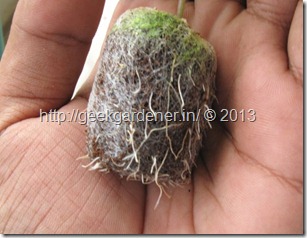
I explained about getting the seedlings ready so far. Now onto the raft system itself. This kit can be purchased from Garden Guru store for those who are interested. The system consists of a tray and a lid. The lid has holes made in it so that the netpots can be placed with the seedling. In total, there can be 12 plants grown at a time. Once placed, the bottom of the netpot just touch the surface of the nutrient solution in the bottom tray.
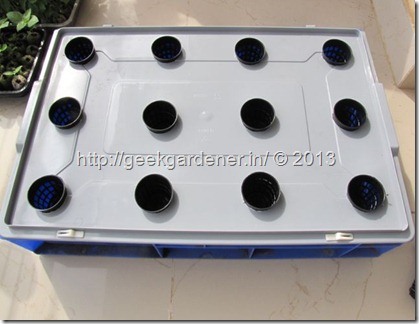
Netpot placed in the hole made.

In this image, I have filled the bottom tank with the nutrient solution meant for growing basil. I used a grow formula nutrient available @ Garden Guru Store in the name of “General Grow”. Grow formula is for promoting leafy growth which is exactly what we want from a plant like Basil. Anyway.. Fill the tank with nutrient solution such that the bottom of the netpot just touches the solution. It can be little above as well but ensure the roots of the seedlings don’t completely drown in the system.

Transplanting:
In a paragraph above, I mentioned that transplanting is a piece of cake when it comes to using plugs. It is! Just take the plug with the seedling from where you grew all the seedlings and simply place it in the net-pot. That’s it. Ensure the plugs don’t dry out for a week or so. If they seem dry, just water it a little bit. In a week’s time, the roots will start growing down and they will take the nutrients by themselves. The transplanting was done on July 6th.

One week later, on July 15th the plants look like below. A visible growth can be observed. Basil grows vigorously once it is planted in a hydroponic system. The plants must be watched everyday for growth and also for pest incidence. Usually basil is very less prone to pests but one cannot rule them out. Watch out for pests.

While it is important to pay attention to the leafs and shoots of the plant, it is equally important that you monitor the health of the root system. Especially in hydroponics, where the plants are grown exclusive in a nutrient solution, it is possible that the roots may rot due to lack of sufficient dissolved oxygen. This oxygen deficit can result in root rot. Signs of root rot are browning of roots and slimy nature of the rotten roots. Sometimes it may also stink. White roots are a sign of healthy root system. Nice white roots can be seen in the picture below. An air pump was used to circulate/oxygenate the solution. However it is not shown in this picture.

The plant is about 2 weeks old and the growth is very clearly visible. The plants started to branch and the smell of basil is all over the place. I did keep a watch on pest incidence and fortunately didn’t find any.
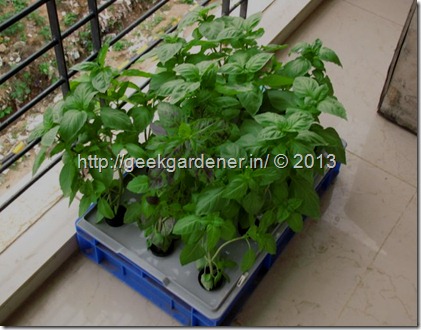
The picture below was of the roots of the basil plants two weeks later. The roots do get all tangled and mixed with one another and we are totally ok with that ;). White healthy roots with no signs of rot. The nutrient level started to go down slowly due to plant consumption and evaporation.

This is how it looked 3 weeks later. By then it was ready for harvest. In the kit, I also got some sporty basil plants with few streaks of purple coloration on the leaves. The plants were growing very vigorously and the growth can be seen in the following picture. At this point, the nutrient solution was depleting. I changed the solution and filled it up with a fresh one.

Pictured below is the harvest done on 4th week after transplanting. This is just one bunch and we got several after that. This system proved out to be a very simple one and ideal for growing herbs like basil, mint etc in small quantities. One can also put different plants in different growing sites provided in the kit. Technically one can grow 12 different herbs in this kit. How do you like that?
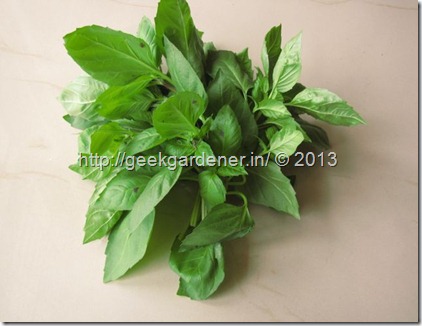
The kit discussed in this post is available for sale if anyone is interested in it. The kit comes with the following
- Container with lid ( holes premade, but can be customized)
- Nutrient solution for growing herbs
- Seeds of Herbs
- Net pots
- Grow plugs
Interested can contact me info@geekgardener.in with the subject “Herb Kit” or you can place an order via this link Garden Guru Hydroponic Kit
Hope you all enjoyed this article.
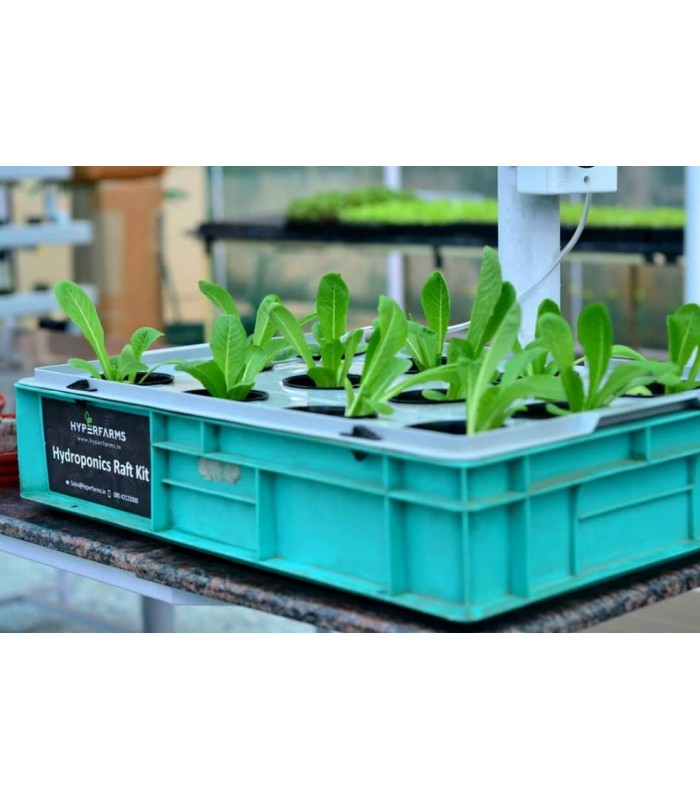



21 Responses
Can I use this kit to grow spinach, coriander and methi. Also, can I use this kit to grow tomato plants.
Regards
Sushmita
Will the kit also include Starting Plugs for seeds?
Regards
Sushmita
Yes , this includes the starter plugs for seeds.
i am a farmer . i want to know more about hydrophobic farming.
please guide me.
The kit is Out of Stock on the Garden Guru site. When will it be available again? I want to purchase it.
Also, can I also grow spinach, coriander and methi using this kit.
Regards
Sushmita
Sushmita,
The initial stock sold out however you should be able to order it now ( I have restocked them).
Thanks
GG
I have bought this kit but am not sure how to create the nurient solution. How much of the nutrient should I mix in water to create one litre of the solution. There are two packets each containing powder. Do I need to mix both the powders in water and in how much quantity?
Waiting eagerly for your response.
Regards
Sushmita
Hi GG,
Been an ardent fan of your blog for the past one year and have been heavily inspired to start an OTG and continue to carry out experiments with soil less cultivation.
This system is a wonderful way to grow greens for a home kitchen gardener.I have also been thinking of easier DIY ways. Can I use a thermacol sheet(available in stationary stores), cut holes through it to fit in the netted pots and make this system work? What do you think will be the drawbacks of using thermacol? Any other suggestions you have?
Will be great to see your feedback.
Thanks,
Vasupradha
hi vasupradha,
i dont see any drawbacks in thermocol..( i could be wrong as well) as far as growing is concerned. just ensure it has good thickness so that it doesn break. and also use heat to cut holes taht way you will get nicely cut holes. please post a pic or two once you have completed your diy! good luck
[…] How to grow Herbs in a Hydroponic Raft system […]
I have bought this kit but am not sure how to create the nurient solution. How much of the nutrient should I mix in water to create one litre of the solution. There are two packets each containing powder. Do I need to mix both the powders in water and in how much quantity?
Sent you a doc with instructions.
hey gg
just wanted to say fantastic job. I just came across this site , and i must say it is very informative.
Thank you for sharing all this information with everyone. I also wanted to ask you if you have tried using the kratky method for the deep water raft system. I’m sure you must have , just wanted your feedback if the method is as good and productive.
thanks
[…] Effectively Grow Herbs In A Hydroponic Raft System (adsbygoogle = window.adsbygoogle || []).push({}); Follow Sign Up Now for Free Updates and Exclusive Content: […]
Can you please suggest me a good link or Books for complete understanding the Hydro and Aquaponics. including the nutritian chart
Impressed… Can I get this kit in Pune?
Will you ship it or do you have any local supplier here in pune?
Thanks,
Shivaji
Very pleasant ! Can we plant in it such as Brinjal, Broccoli, Cabbage, Capsicum, Cauliflower,Lady’s Finger, Spinach, Tomato, etc.
Hi,
I thank you for your good job. Its really awesome !!! Hats off to you !!
I have few basic questions.. Would you pls answer them.
1. For Raft system of hydroponics, should we run the aerating motor 24/7 or just few hours a day is sufficient?
2. For the tubular type of hydroponics also, should the water be circulated throughtout? 24/7?
3. Can i try Spinach, cauliflower, cabbage in Chennai? (I meant the hot climate here).
regards
John
Very informative and practicable article. Is the kit available
in Ludhiana or Chandigarh.
You can order it from gardenguru.in
[…] How To Grow Herbs In A Hydroponic Raft System […]